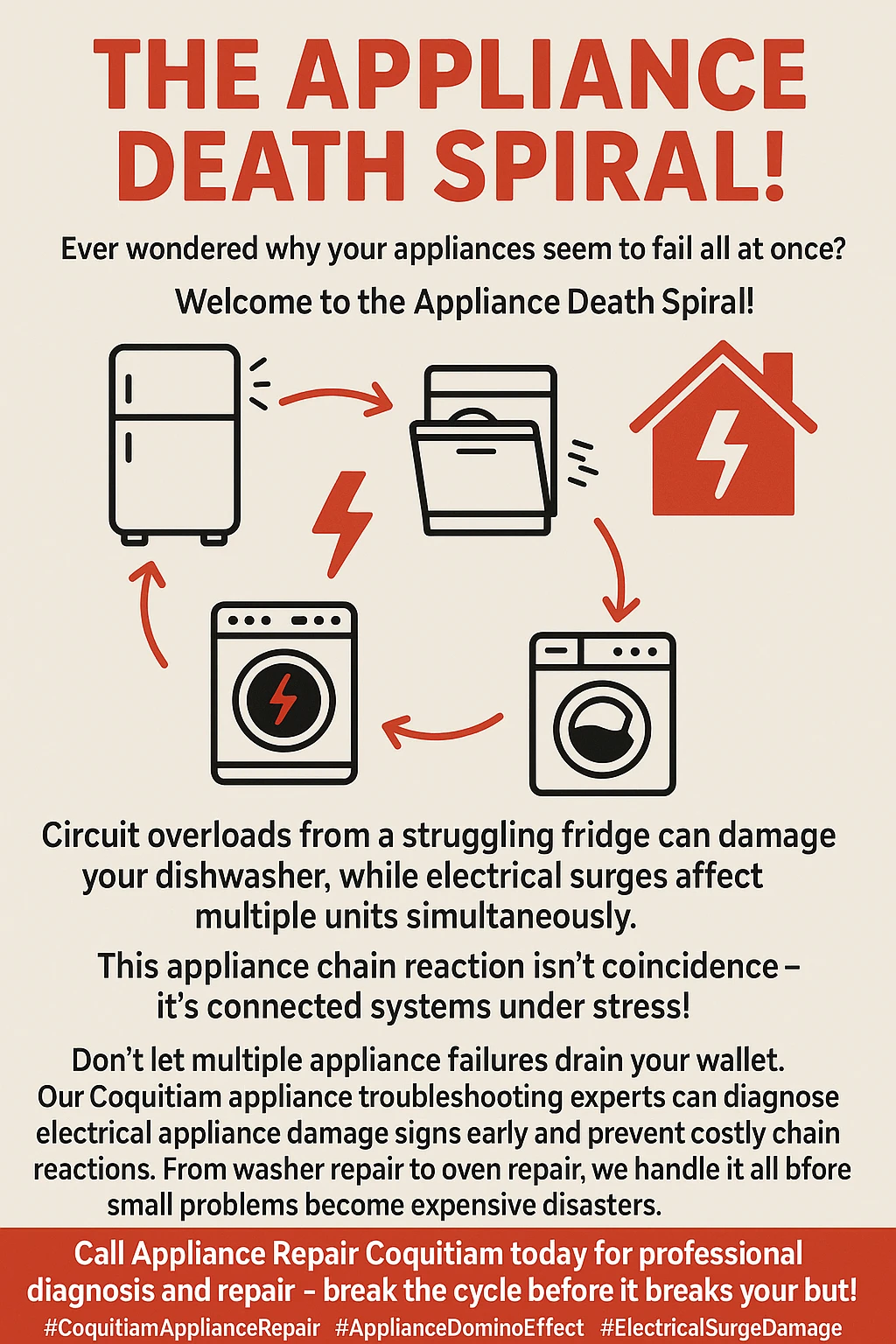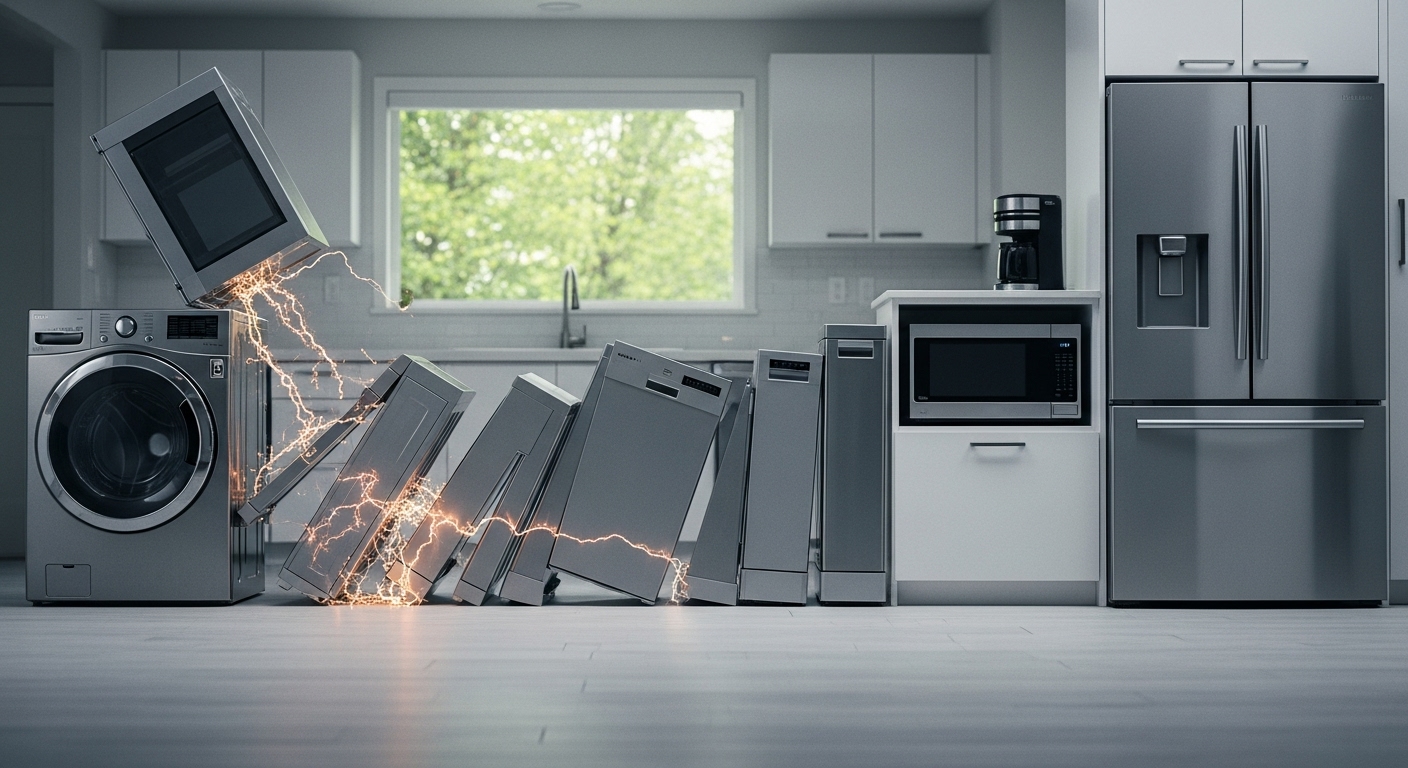Ever wondered why your dishwasher suddenly stopped working right after your washing machine started making weird noises? You’re not alone – when one appliance begins to fail in your Coquitlam home, it often triggers a domino effect that can leave you facing multiple expensive repairs all at once.
Picture this: you’re loading the dishwasher after dinner when you notice it’s not draining properly. A few days later, your microwave starts flickering. Then your refrigerator begins making strange humming sounds. What feels like terrible luck is actually something much more predictable – and preventable. This phenomenon, known as the appliance death spiral, occurs when one failing appliance creates conditions that damage or stress other appliances in your home, leading to a cascade of breakdowns that can cost thousands of dollars to fix.
The death spiral isn’t just bad luck or coincidence. It’s a legitimate engineering phenomenon where the failure of one component in an interconnected system triggers successive failures throughout the network. In your Coquitlam home, appliances share electrical circuits, plumbing lines, and ventilation systems in ways that make them far more connected than most homeowners realize. When one appliance begins drawing excessive power, sending electrical surges, or creating vibrations and heat, these effects ripple through your home’s infrastructure like dominoes falling in sequence.
Understanding how this cascade works – and more importantly, how to prevent it – has become essential for modern homeowners. With appliances becoming increasingly complex and interconnected, and with the unique environmental challenges that come with living in British Columbia’s coastal climate, Coquitlam residents need to think strategically about appliance maintenance and system protection. The good news? Once you understand the warning signs and implement the right prevention strategies, you can break the chain reaction before it empties your wallet.
Key Outtakes:
- Failing appliances can trigger cascade failures through shared electrical circuits, causing power surges that damage other connected devices
- Modern appliances are intentionally designed with shorter lifespans and more failure points than older models, increasing cascade risk
- Coquitlam’s coastal climate accelerates appliance degradation through humidity, salt air, and hard water conditions
- Early warning signs like unusual noises, flickering lights, and tripped breakers can help you prevent cascade failures before they start
- Professional maintenance and electrical system upgrades provide the most cost-effective protection against expensive multi-appliance failures

The Electrical Connection: How Shared Circuits Create Vulnerability

The foundation of the appliance death spiral lies in how your home’s electrical system distributes power. Most residential circuits are designed to handle between fifteen and twenty amps of current, but modern appliances frequently push these limits to their breaking point. When multiple high-wattage devices operate on the same circuit – think your microwave, coffee maker, and toaster all running during busy morning routines – you’re already dancing on the edge of an overload situation.
What makes this situation truly dangerous is how failing appliances behave electrically. A refrigerator with a struggling compressor doesn’t just use more energy; it creates electrical irregularities that affect every other device on that circuit. If one appliance uses excessive power due to a defect, it may increase your home’s overall energy load, adding strain that reduces efficiency and contributes to premature wear on other electronics and appliances. This isn’t speculation – it’s measurable electrical stress that accumulates over time.
The problem intensifies in homes with shared circuit configurations, which remain common throughout Coquitlam’s older neighborhoods. Your kitchen outlets might share a circuit with your living room or bathroom, meaning someone blow-drying their hair while you’re running the blender could unknowingly create an overload situation. When an appliance starts failing and drawing irregular power, it reduces the available capacity for everything else on that circuit, creating a perfect storm for cascade failures.
Circuit breakers trip as a safety mechanism when electrical demand exceeds safe limits, but many homeowners treat this as a minor inconvenience rather than a serious warning. Each time a breaker trips, it’s protecting your home from wiring that was heating dangerously close to failure. More critically, if a specific appliance caused that trip by sending a surge through the circuit, simply resetting the breaker while leaving the faulty appliance connected guarantees the surge will happen again, incrementally damaging other appliances with each occurrence.
Modern homes in Coquitlam face additional electrical challenges that amplify cascade risk. Energy-efficient appliances often contain sensitive electronic components that can be permanently damaged by even small power surges originating from failing units on the same circuit. Your dishwasher’s computerized control panel, your microwave’s digital display, your refrigerator’s temperature sensors – all of these sophisticated systems become vulnerable when electrical conditions destabilize due to one appliance’s decline.
Power Surge Damage: The Hidden Destroyer

Power surges represent perhaps the most insidious mechanism through which appliance death spirals propagate throughout your home. Unlike the dramatic electrical failures you see in movies, most surge damage occurs silently and incrementally, weakening appliance components over weeks or months before catastrophic failure occurs. This makes surge damage particularly dangerous because homeowners rarely connect the dots between an initial appliance problem and the seemingly unrelated failures that follow.
When appliances malfunction, they can generate significant electrical disturbances that travel through your home’s wiring like shock waves. Broken appliances can send surges of electricity into your home’s electrical system, with the resulting damage ranging from barely perceptible wear on sensitive components to devastating electrical shorts that can spark fires. The most vulnerable targets are the microprocessor-based electronics that control modern appliances – the digital displays, computerized timers, and smart features that make contemporary appliances so convenient.
These microprocessors can receive permanent damage almost instantaneously from large surges, but they more commonly experience cumulative damage from smaller surges that progressively reduce device lifespan and performance. Imagine your failing refrigerator sending small electrical hiccups through your kitchen circuit several times per day. Each surge weakens your dishwasher’s control board a little, degrades your microwave’s electronics slightly, and stresses your garbage disposal’s motor incrementally. Over months, this accumulated damage transforms multiple functional appliances into units operating on borrowed time.
Beyond the electronic damage, power surges can literally burn physical components within your electrical system. Light switches, outlets, and connection points contain delicate materials that can be scorched or melted by electrical surges in fractions of a second. When you examine these components after significant surge activity, you often discover telltale scorch marks and melted plastic – physical evidence of the electrical violence that occurred when your appliances were fighting for stable power.
The worst-case scenario involves electrical shorts that spark actual fires. While less common than incremental damage, these catastrophic outcomes represent the ultimate expression of how one failing appliance can cascade into home-threatening consequences. Even small electrical fires that burn out on their own inside metal appliances can ignite insulation, nearby materials, or create conditions for larger fires to develop.
The Complexity Trap: Why Modern Appliances Fail More Often

A fundamental paradox defines today’s household appliances: they perform more functions and offer greater convenience than ever before, yet they fail more frequently and more completely than the simpler appliances of previous generations. This contradiction isn’t accidental – it stems from deliberate design choices driven by consumer demands for features, energy efficiency, and competitive pricing. Understanding this complexity trap helps explain why cascade failures have become increasingly common in modern homes.
Contemporary appliances contain substantially more components than their predecessors, with each additional component representing a potential point of failure. Your washing machine can text you when a load is done; your HVAC system tells you when to reduce temperatures to save money; your refrigerator reminds you of your schedule. Beneath these convenient features lies a dense network of sensors, switches, circuits, and computerized controls that simply didn’t exist in appliances from previous decades.
While these technological improvements ensure appliances use only the energy, water, and resources they actually need, the trade-off proves severe in terms of reliability. More components equals more complexity, which equals exponentially more potential failure points. When any single component in this complex network fails, it can trigger malfunctions throughout the entire appliance system,